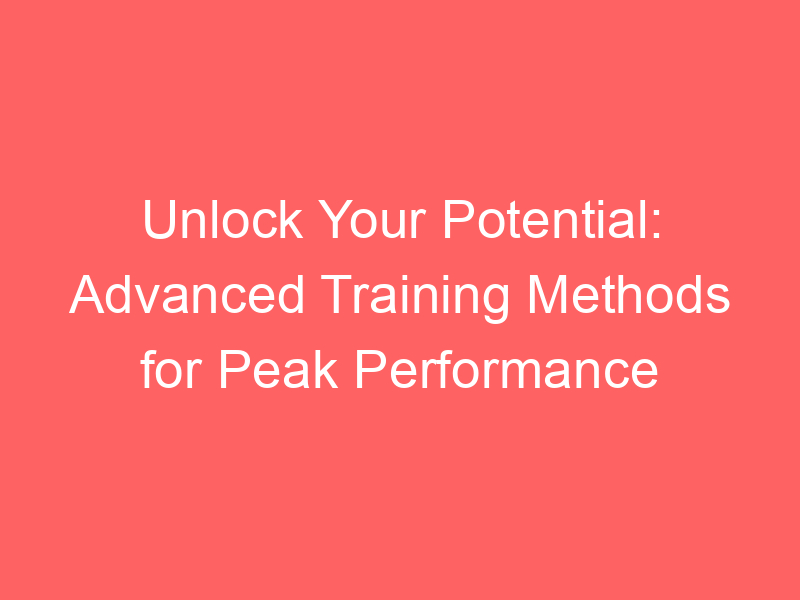
Introduction to Performance Enhancement Training
Welcome to the world of Performance Enhancement Training! This is a special type of training that focuses on improving an athlete’s performance in their specific sport. It’s all about pushing your limits and reaching new heights. But what exactly does it involve? Let’s find out.
- Understanding the concept of Performance Enhancement Training
- Importance of Performance Enhancement Training for athletes
Performance Enhancement Training, often referred to as PET, is a specialized form of training that focuses on improving an athlete’s specific skills and abilities. It’s not just about being fit or strong, but about being better at your sport. This could involve improving your speed, agility, strength, endurance, or any other skill that’s important in your sport.
For example, a basketball player might work on their shooting accuracy, while a marathon runner might focus on their endurance. The key is that the training is tailored to the athlete’s specific needs and goals.
So why is Performance Enhancement Training so important for athletes? Well, in the world of sports, every second counts. A fraction of a second can be the difference between winning and losing. That’s why athletes are always looking for ways to improve their performance.
Performance Enhancement Training can help athletes reach their full potential. It can help them improve their skills, increase their fitness levels, and even prevent injuries. Plus, it can give them a mental edge, boosting their confidence and focus.
Take the case of Usain Bolt, the fastest man on earth. He didn’t just become the fastest by chance. It was the result of years of dedicated Performance Enhancement Training. He worked on his speed, his technique, and his mental toughness. And the result? He became an Olympic champion and a world record holder.
So, if you’re an athlete looking to improve your performance, consider Performance Enhancement Training. It could be the key to unlocking your full potential.
Advanced Training Techniques for Maximizing Athletic Performance
When it comes to maximizing athletic performance, there are several advanced training techniques that can be utilized. These methods are designed to push the body to its limits, helping athletes to improve their strength, speed, and endurance. Let’s delve into some of these high-performance training methods.
High-Performance Training Methods
There are three main types of high-performance training methods that athletes can use to improve their performance. These include interval training, resistance training, and plyometric training. Each of these methods has its own unique benefits and can be used in different ways to enhance athletic performance.
- Interval Training
- Resistance Training
- Plyometric Training
Interval training involves alternating between high-intensity and low-intensity exercise periods. This method is particularly effective for improving cardiovascular fitness and burning fat. For example, an athlete might sprint for 30 seconds, then walk for 60 seconds, repeating this cycle for a set amount of time.
Resistance training, also known as strength training, involves using weights or other forms of resistance to build muscle strength and endurance. This type of training can help athletes to improve their power and speed, as well as their overall body composition. A typical resistance training session might involve exercises like squats, lunges, and bench presses.
Plyometric training involves performing explosive, high-intensity movements that aim to increase speed and power. This type of training can be particularly beneficial for athletes who need to perform quick, explosive movements in their sport, such as basketball players or sprinters. Examples of plyometric exercises include box jumps and burpees.
In conclusion, interval training, resistance training, and plyometric training are all effective high-performance training methods that can be used to maximize athletic performance. By incorporating these techniques into their training regimen, athletes can push their bodies to new limits and achieve their performance goals.
Advanced Fitness Training
When it comes to maximizing athletic performance, advanced fitness training plays a crucial role. This type of training includes different methods that help athletes improve their skills and reach their full potential. Let’s delve into two of these techniques: Circuit Training and Functional Fitness Training.
- Circuit Training
Circuit training is a form of body conditioning that involves endurance training, resistance training, high-intensity aerobics, and exercises performed in a circuit, or series. This type of training is designed to be rigorous and challenging, pushing athletes to their limits.
Here’s an example of a simple circuit training routine:
| Exercise | Repetitions |
|---|---|
| Push-ups | 15 |
| Squats | 20 |
| Jumping Jacks | 30 seconds |
| Plank | 45 seconds |
Remember, the goal of circuit training is to complete each exercise as quickly as possible, with minimal rest in between. This helps to improve cardiovascular fitness and muscular strength.
- Functional Fitness Training
Functional fitness training is a type of exercise that prepares your body for real-life movements and activities, rather than something specific to a sport. It trains your muscles to work together and prepares them for daily tasks by simulating common movements you might do at home, at work, or in sports.
For example, a squat is a functional exercise because it trains the muscles used when you rise up and down from a chair or pick up low objects. By training your muscles to work the way they do in everyday tasks, you prepare your body to perform well in a variety of situations.
Whether you’re an athlete looking to improve your performance or someone who just wants to stay fit and healthy, incorporating advanced fitness training techniques like circuit training and functional fitness training into your routine can make a big difference. Remember, the key to success in fitness is consistency and dedication.
Performance Training Strategies for Peak Performance
When it comes to achieving peak performance, it’s not just about the amount of time you spend training, but also the quality of your workouts. Let’s explore some advanced workout methods that can help you reach your full potential.
Advanced Workout Methods
There are a variety of advanced workout methods that can help you push past your limits and reach new levels of performance. Here are two of the most effective ones:
- Superset Workouts
- Tabata Training
Superset workouts involve performing two exercises back-to-back without any rest in between. This method not only saves time but also increases the intensity of your workout, leading to improved muscle growth and endurance. For example, you might do a set of push-ups followed immediately by a set of pull-ups. This keeps your muscles engaged and working hard throughout your entire workout.
Tabata training is a form of high-intensity interval training (HIIT) that involves 20 seconds of intense exercise followed by 10 seconds of rest, repeated eight times for a total of four minutes. This method is incredibly effective at improving both aerobic and anaerobic fitness. A study published in the Journal of Physiology found that participants who did Tabata training for six weeks improved their aerobic capacity by 14% and their anaerobic capacity by 28%.
Remember, these advanced workout methods are intense and should be approached with caution. Always listen to your body and consult with a fitness professional before starting a new workout regimen.
Maximizing Training Efficiency
Training efficiency is a crucial aspect of performance enhancement. It is not just about how much effort you put in, but also about how smartly you train. Two key factors that significantly impact training efficiency are rest and recovery, and nutrition. Let’s delve into these aspects.
- Importance of Rest and Recovery
- Role of Nutrition in Training Efficiency
Rest and recovery are often overlooked but are vital components of an effective training program. They allow your body to repair and strengthen itself in between workouts. It also helps to replenish energy stores and reduce fatigue. Without sufficient recovery, your performance can suffer, and you may even risk injury.
According to a study by the National Sleep Foundation, athletes who get an adequate amount of sleep have better performance, speed, accuracy, and reaction times. So, remember to incorporate rest days into your training schedule and ensure you’re getting enough sleep each night.
Nutrition plays a significant role in training efficiency. The food you eat provides the energy needed to perform your workout. Proper nutrition can help enhance athletic performance, delay the onset of fatigue, promote recovery, and protect against injury.
Proteins, carbohydrates, and fats are the primary sources of energy. Proteins are essential for muscle repair and growth, carbohydrates provide energy, and fats help in hormone production and nutrient absorption. A balanced diet that includes these nutrients can significantly improve your training efficiency.
| Nutrient | Role in Training |
|---|---|
| Proteins | Muscle repair and growth |
| Carbohydrates | Energy provision |
| Fats | Hormone production and nutrient absorption |
In conclusion, maximizing training efficiency is not just about pushing harder but also about taking care of your body. Remember to rest, recover, and fuel your body with the right nutrients to achieve peak performance.
High-Intensity Training Methods for Enhanced Performance
High-intensity training methods are designed to push your body to its limits, helping you achieve peak performance. These methods often involve short bursts of intense exercise followed by brief periods of rest. Let’s delve into some advanced sports training techniques that can help enhance your performance.
Advanced Sports Training Techniques
Advanced sports training techniques are designed to help athletes improve their performance by focusing on specific aspects of their physical abilities. These techniques often involve specialized exercises and drills that target specific muscle groups and skills. Here are two key techniques:
- Speed and Agility Drills
- Power and Strength Training
Speed and agility drills are designed to improve an athlete’s quickness and flexibility. These drills often involve running through a series of cones, jumping over hurdles, or sprinting short distances. For example, the “zig-zag” drill involves running as fast as possible in a zig-zag pattern between a series of cones. This drill not only improves speed but also enhances agility by forcing the athlete to change direction quickly.
Power and strength training involves lifting weights or performing bodyweight exercises to build muscle mass and increase strength. For instance, squats and deadlifts are common strength training exercises that target the lower body muscles. These exercises not only enhance power but also improve overall athletic performance by building a strong foundation.
In conclusion, high-intensity training methods, including advanced sports training techniques like speed and agility drills and power and strength training, can significantly enhance athletic performance. By incorporating these techniques into your training regimen, you can push your body to its limits and achieve peak performance.
Conclusion: Unlocking Your Potential with Advanced Training
In this article, we’ve journeyed through the world of performance enhancement training, exploring advanced techniques and strategies. Now, let’s recap what we’ve learned and look ahead to the future trends in this field.
- Recap of Advanced Training Methods
We’ve discussed a variety of advanced training methods, each with its own unique benefits. High-intensity training, for example, pushes your body to its limits, helping you build strength and endurance. We’ve also explored strategies for peak performance, such as setting clear goals and maintaining a positive mindset.
Remember, the key to unlocking your potential lies in consistency and dedication. Advanced training isn’t a quick fix; it’s a journey. But with the right techniques and strategies, you can reach new heights in your athletic performance.
- Future Trends in Performance Enhancement Training
As we look to the future, we see exciting trends emerging in performance enhancement training. One such trend is the use of technology to track and analyze performance. Wearable devices and apps can provide real-time feedback, helping athletes fine-tune their training and reach their goals faster.
Another trend is the growing focus on mental training. More and more, coaches and athletes are recognizing the importance of mental strength and resilience in achieving peak performance. Techniques such as mindfulness and visualization are becoming integral parts of training programs.
As these trends continue to evolve, they will open up new possibilities for athletes seeking to unlock their potential. The future of performance enhancement training is bright, and we can’t wait to see where it takes us.
Thank you for joining us on this journey through advanced training. We hope you’ve found this information helpful and inspiring. Remember, the key to unlocking your potential is in your hands. With the right training and mindset, you can achieve anything you set your mind to.









